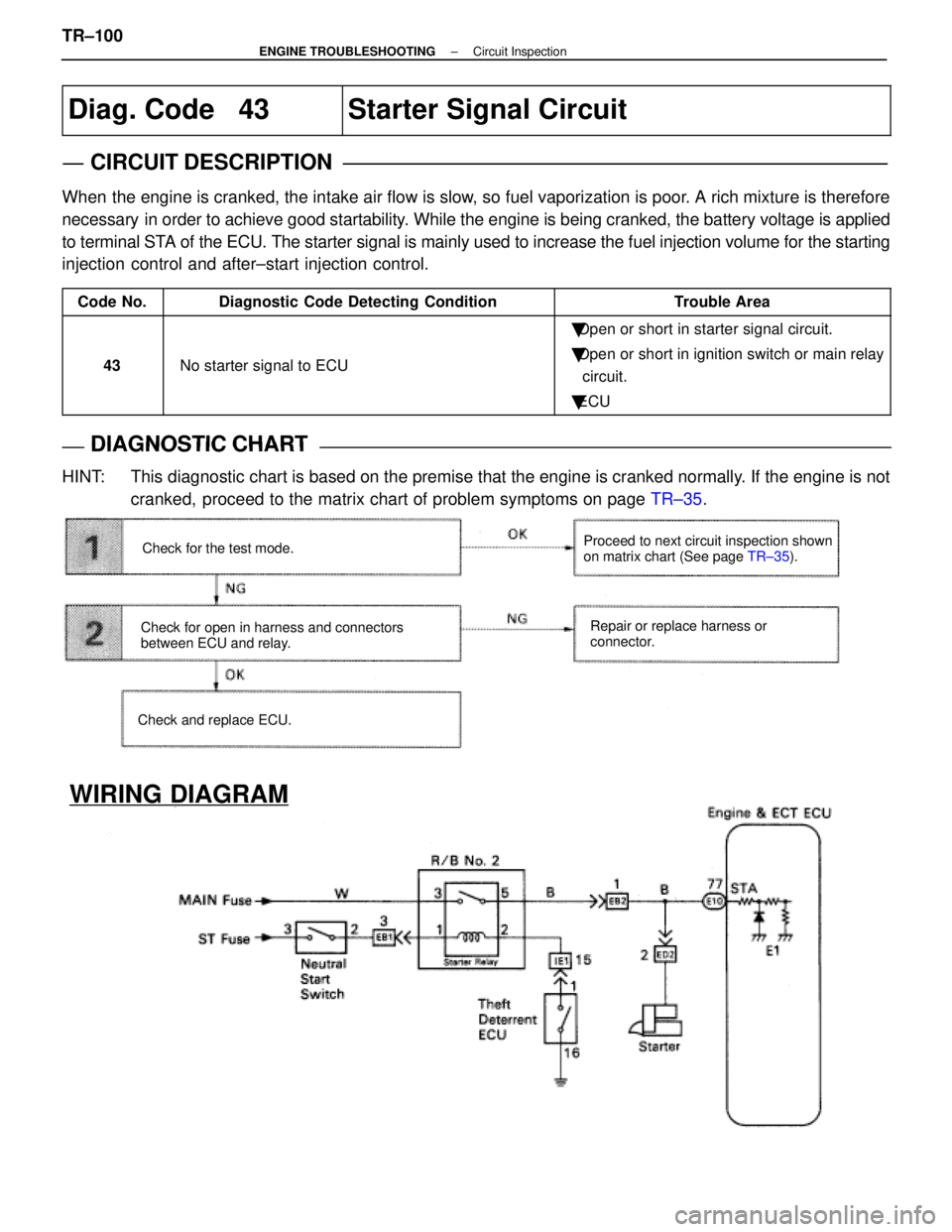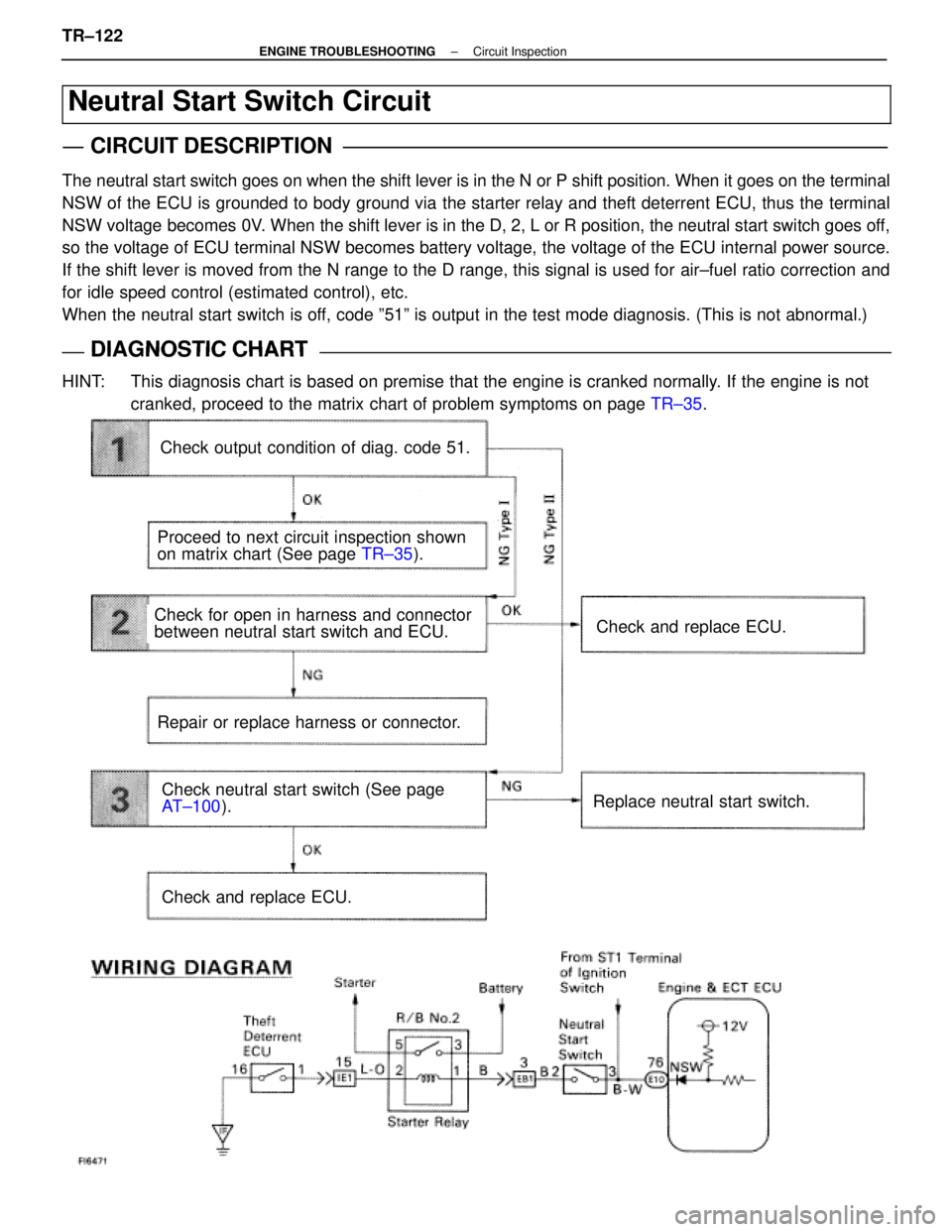Page 2669 of 4087
OKNG
OKNG
6Check for open and short in harness and connector between ignition relay and \
ignition coil,
ignition coil and igniter (See page IN±27).
Repair or replace harness or connector
#Check ignition coil.
C
OK
PDisconnect ignition coil connector.
(For No. 1 ignition coil (on left bank), remove the battery)
(2) Check primary coil. Measure resistance between terminals of ignition
coil connector.
(2) Check secondary coil. Measure resistance between terminal 1 of ignition
coil connector and high±tension terminal.
Replace ignition coil.
Replace Igniter. *1
*1: When diag. code 14 is displayed, replace the igniter with 5 wire harness. (extra wire is for tachometer). When diag.
code 15 is displayed, replace the igniter with 4 wire har-
ness
TR±58±
ENGINE TROUBLESHOOTING Circuit Inspection
WhereEverybodyKnowsYourName
Page 2670 of 4087
OKNG
8Check Ignition Relay.
C
OK
P
C
OK
Remove ignition relay.
Check continuity between terminals of ignition relay
shown below.
(2) Apply battery voltage between terminals 3 and 6, 4and 5.
(2) Check continuity between terminals 1 and 2.
Replace ignition relay.
Check and repair harness or connector between
battery and ignition relay, ignition relay and igni-
ter.
±
ENGINE TROUBLESHOOTING Circuit InspectionTR±59
WhereEverybodyKnowsYourName
Page 2676 of 4087
OKNG
OKNG
INSPECTION PROCEDURE
1Disconnect the engine & ECT ECU connector, check voltage between terminals HTL1, HTR1 of
engine & ECT ECU connector and body ground.
C
OK
P(2) Connect the Check Harness A.(See page TR±30)
(2) Disconnect engine & ECT ECU connector.
(2) Turn ignition switch on.
Measure voltage beween terminals HTL1, HTR1 of en-
gine & ECT ECU connector and body ground.
Voltage: 10 ± 14 V
Go to step [3].
2Check main oxygen sensor heater.
C
OK
PDisconnect main oxygen sensor connector.
Measure resistance between terminals 1 and 2 of main
oxygen sensor connector.
Resistance: 5.1 ± 6.3 � at 20 �C (68 �F)
Replace main oxygen sensor.
Check and repair harness or connector between
main relay and main oxygen sensor, main oxygen
sensor and engine & ECT ECU.
TR±65±
ENGINE TROUBLESHOOTING Circuit Inspection
WhereEverybodyKnowsYourName
Page 2696 of 4087
NGOK
OKNG
INSPECTION PROCEDURE
1Disconnect the engine & ECT ECU connector.
C
OK
P(2) Connect the Check Harness A.(See page TR±30)
(2) Disconnect engine & ECT ECU connector.
(2) Turn ignition switch on.
Measure voltage between terminals HTL2, HTR2 of en-
gine & ECT ECU connector and body ground.
Voltage: 10 ± 14 V
Go to step [3].
2Check sub±oxygen sensor heater.
C
OK
PDisconnect sub±oxygen sensor connector.
Measure resistance between terminals 1 and 2 of sub±
oxygen sensor connector.
Resistance: 5.1 ± 6.3 � 20 �C (68 �F)
Replace sub±oxygen sensor.
Check and repair harness or connector between
main relay and sub±oxygen sensor, sub±oxygen
sensor and engine & ECT ECU.
±
ENGINE TROUBLESHOOTING Circuit InspectionTR±85
WhereEverybodyKnowsYourName
Page 2711 of 4087

Diag. Code 43Starter Signal Circuit
CIRCUIT DESCRIPTION
When the engine is cranked, the intake air flow is slow, so fuel vaporization is poor. A rich mixture is therefore
necessary in order to achieve good startability. While the engine is being cranked, the battery voltage is applied
to terminal STA of the ECU. The starter signal is mainly used to increase the fuel inj\
ection volume for the starting
injection control and after±start injection control.
Code No.Diagnostic Code Detecting ConditionTrouble Area
43No starter signal to ECU
�Open or short in starter signal circuit.
� Open or short in ignition switch or main relay
circuit.
� ECU
DIAGNOSTIC CHARTDIAGNOSTIC CHART
HINT: This diagnostic chart is based on the premise that the engine is cranked nor\
mally. If the engine is not
cranked, proceed to the matrix chart of problem symptoms on page TR±35.
Check for the test mode.
Check for open in harness and connectors
between ECU and relay.
Check and replace ECU. Proceed to next circuit inspection shown
on matrix chart (See page
TR±35).
Repair or replace harness or
connector.
WIRING DIAGRAM
TR±100±
ENGINE TROUBLESHOOTING Circuit Inspection
WhereEverybodyKnowsYourName
Page 2712 of 4087
NGOK
OKNG
v
INSPECTION PROCEDURE
1Check output condition of diag. code 43.
C
OK
P
OK
C
Setting the test mode.
(2) Turn ignition switch OFF.
(2) Connect terminals TE2 and E1 of TDCL.
(2) Turn ignition switch ON.(Don't start the engine)
(2) Connect terminals TE1 and E1 of TDCL.
Check if code ª43º is output by the ªCHECKº engine
warning light.
Code ª43º is output.
Start the engine.
Check if the code ª43º disapears.
Code ª43º is not output.
Proceed to next circuit inspection shown on maxtric
chart (See page TR±35).
2Check for open in harness and connectors between engine & ECT ECU and st\
arter relay
(See page IN±27).
Repair or replace harness or connector.
Check and replace engine & ECT ECU.
±
ENGINE TROUBLESHOOTING Circuit InspectionTR±101
WhereEverybodyKnowsYourName
Page 2727 of 4087
OKNG
NGOK
OKNG
INSPECTION PROCEDURE
1Check fuel pump operation.
C
OK
P(2) Turn ignition switch ON.
(2) Using SST. connect terminals + B and FP of checkconnector.
SST 09843±18020
Check that there is projection of the head of the pulsa-
tion damper screw.
Projection of the head of the pulsation damper
screw.
Go to step 3.
2Check for open and short in harness and connector between terminals + B e + B FP e FP of
the check connector and fuel pump ECU (See page IN±27).
Go to step 5.
Repair or replace harness or connector.
3Check voltage or terminal + B of check connector.
C
OK
PTurn ignition switch ON.
Measure voltage between terminal + B of check connec-
tor and body ground.
Voltage: 10 ± 14 V
Check for ECU power source circuit
(See page TR±124), and check for open in harness and
connector between terminal + B of check connector and
main relay.
TR±116
±
ENGINE TROUBLESHOOTING Circuit Inspection
WhereEverybodyKnowsYourName
Page 2733 of 4087

Neutral Start Switch Circuit
CIRCUIT DESCRIPTION
The neutral start switch goes on when the shift lever is in the N or P shif\
t position. When it goes on the terminal
NSW of the ECU is grounded to body ground via the starter relay and theft deterrent ECU\
, thus the terminal
NSW voltage becomes 0V. When the shift lever is in the D, 2, L or R position, the neutral start\
switch goes off,
so the voltage of ECU terminal NSW becomes battery voltage, the voltage of the ECU internal power source.
If the shift lever is moved from the N range to the D range, this signal\
is used for air±fuel ratio correction and
for idle speed control (estimated control), etc.
When the neutral start switch is off, code º51º is output in the test mode diagnosis. (This is not a\
bnormal.)
DIAGNOSTIC CHARTDIAGNOSTIC CHART
HINT: This diagnosis chart is based on premise that the engine is cranked norm\
ally. If the engine is notcranked, proceed to the matrix chart of problem symptoms on page TR±35.
Check output condition of diag. code 51.
Proceed to next circuit inspection shown
on matrix chart (See page TR±35).
Check for open in harness and connector
between neutral start switch and ECU.
Repair or replace harness or connector.
Check and replace ECU.
Check and replace ECU.
Replace neutral start switch.Check neutral start switch (See page
AT±100 ).
TR±122
±
ENGINE TROUBLESHOOTING Circuit Inspection
WhereEverybodyKnowsYourName